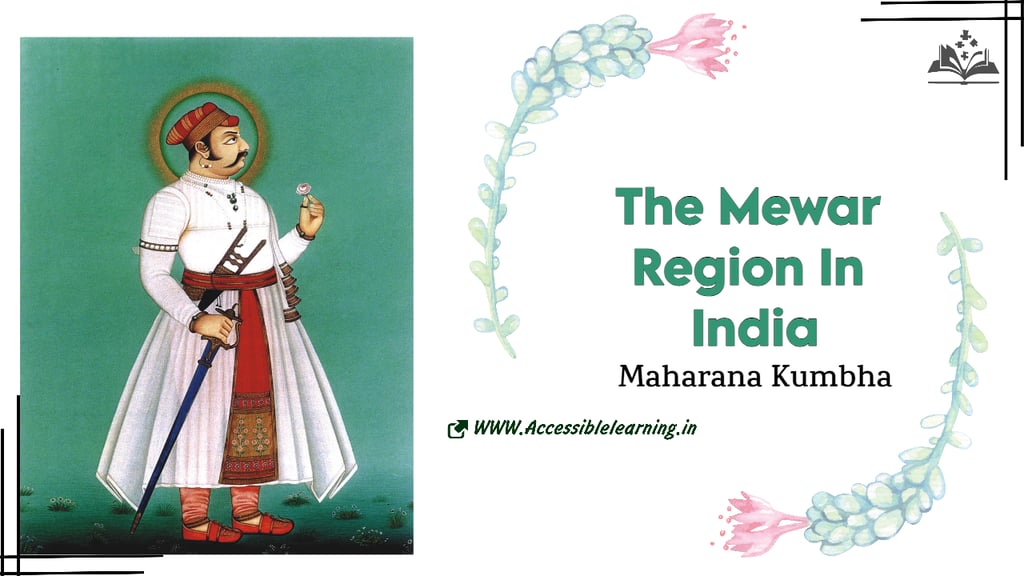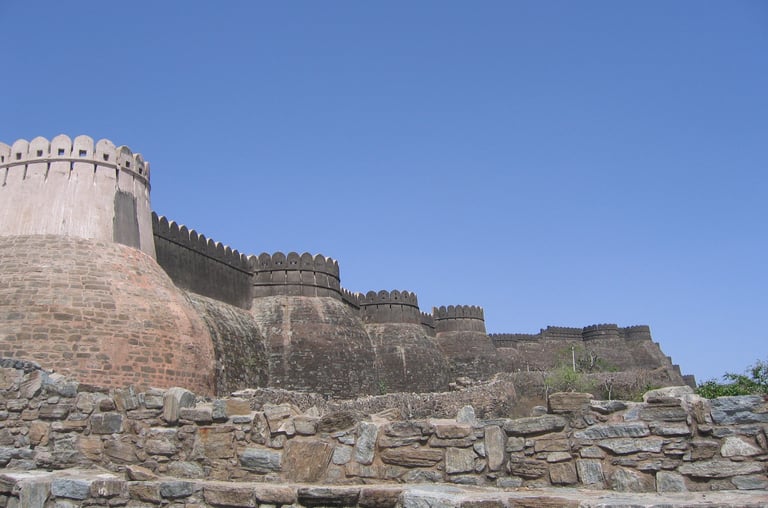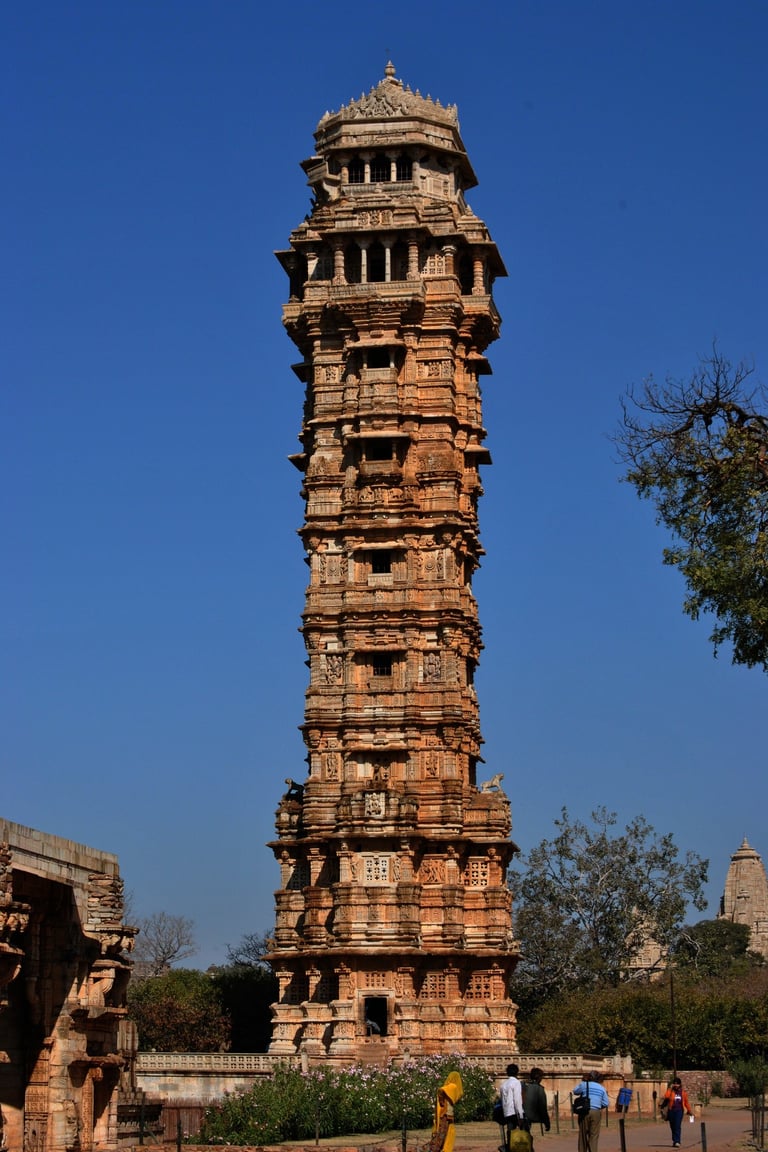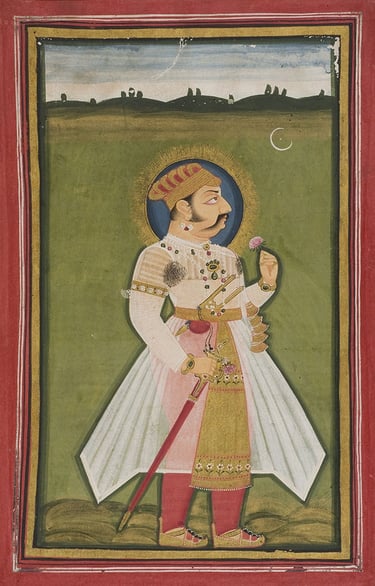
Maharana Kumbha: The Warrior King Who Built India's Greatest Fortresses
Discover the remarkable legacy of Maharana Kumbha (1433-1468 CE), the undefeated warrior king of Mewar who transformed medieval India through architectural masterpieces and military brilliance. Explore his 32 fortresses, including UNESCO World Heritage Sites Kumbhalgarh Fort and Chittorgarh's Vijay Stambh, his scholarly contributions to music and literature, and his unprecedented 35-year reign without a single military defeat. This comprehensive guide covers his early life, strategic victories against multiple sultanates, innovative governance reforms, cultural patronage, and enduring influence on Rajasthani heritage and tourism.
INDIAN HISTORYEMPIRES/HISTORYHISTORY
Sachin K Chaurasiya
8/6/202511 min read


Maharana Kumbha of Mewar stands as one of medieval India's most remarkable rulers, a visionary king who transformed the landscape of Rajasthan through his architectural masterpieces and military prowess. Reigning from 1433 to 1468 CE, Kumbha Singh established himself as the greatest ruler of the Sisodia dynasty, earning recognition as both a formidable warrior and an enlightened patron of arts and architecture.
Born into the royal house of Mewar in 1417 CE, Maharana Kumbha inherited a kingdom under constant threat from neighboring sultanates. His 35-year reign marked a golden age for Mewar, characterized by unprecedented architectural achievements, successful military campaigns, and cultural flourishing that continues to inspire visitors to Rajasthan today.
Early Life and Rise to Power of Maharana Kumbha
Royal Heritage & Family Background
Maharana Kumbha was born as the eldest son of Maharana Mokal Singh of Mewar. The young prince received comprehensive education in statecraft, warfare, architecture, and Sanskrit literature, preparing him for the challenges that lay ahead. His father's assassination in 1433 CE thrust the 16-year-old Kumbha into power during one of Mewar's most turbulent periods.
Ascending the Throne During Crisis
When Kumbha ascended the throne of Mewar, the kingdom faced multiple threats. The Delhi Sultanate under Bahlul Lodi posed challenges from the north, while the Gujarat Sultanate and Malwa Sultanate pressured Mewar from the west and east respectively. These circumstances demanded immediate action from the young ruler, who demonstrated exceptional leadership qualities from the outset of his reign.
Military Campaigns and Victories of Maharana Kumbha
The Battle Against Mahmud Khilji of Malwa
One of Maharana Kumbha's most celebrated military achievements came through his decisive victory over Mahmud Khilji, the Sultan of Malwa, in 1437 CE. This victory not only secured Mewar's eastern borders but also established Kumbha's reputation as a formidable military strategist. Situated in Chittor Fort of Chittorgarh, Vijay Stambh (1440-48) was built by Maharana Kumbha (King of Mewar). It is the representative of victory because Maharana Kumbha had defeated Mahmood Khilji in 1437.
Strategic Alliances & Diplomatic Relations
Maharana Kumbha demonstrated remarkable diplomatic acumen by forging strategic alliances with neighboring Rajput kingdoms while simultaneously maintaining his independence from the major sultanates. His diplomatic strategies included marriage alliances, trade agreements, and mutual defense pacts that strengthened Mewar's position in the complex political landscape of medieval India.
Expansion of Mewar Territory
Under Kumbha's leadership, Mewar expanded significantly, encompassing territories that stretched from the Aravallis to the borders of Gujarat and Malwa. His military campaigns were characterized by swift execution, strategic planning, and the innovative use of fort-based defensive strategies that would influence Rajput warfare for centuries.


Architectural Legacy: The Great Fortresses of Maharana Kumbha
Kumbhalgarh Fort—The Crown Jewel
Kumbhalgarh, also known as the Great Wall of India, is a fortress located on the western range of the Aravalli Hills in Kumbhalgarh, Rajsamand district, Rajasthan, India. Located approximately 48 km (30 mi) from Rajsamand and 84 km (52 mi) from Udaipur, the fort was constructed in the 15th century by Rana Kumbha. The wall of Kumbhalgarh is one of the longest continuous walls in the world, spanning 36 kilometers.
Kumbhalgarh Fort represents the pinnacle of Maharana Kumbha's architectural vision. This massive fortress complex demonstrates advanced engineering techniques and strategic military planning. The fort's walls stretch across 36 kilometers, making it the second-longest continuous wall in the world after the Great Wall of China. The construction required over 15 years and employed thousands of skilled craftsmen and laborers.
Vijay Stambh—The Tower of Victory at Chittorgarh
The Vijay Stambh, or Tower of Victory, stands as Maharana Kumbha's most iconic architectural achievement. Constructed between 1440 and 1448 CE to commemorate his victory over Mahmud Khilji, this nine-story tower rises 37 meters into the sky. The structure showcases intricate carvings depicting Hindu deities, weapons, and musical instruments, representing the cultural synthesis that characterized Kumbha's reign.
Other Architectural Contributions
Beyond his famous fortresses, Maharana Kumbha commissioned numerous temples, palaces, and water conservation systems throughout Mewar. His architectural projects included the renovation and expansion of existing structures at Chittorgarh Fort, the construction of step-wells for water storage, and the development of planned townships around his major fortifications.
Cultural and Religious Patronage
Support for Arts & Literature
Maharana Kumbha's court attracted scholars, poets, musicians, and artists from across India. He personally composed several works in Sanskrit and Hindi, including treatises on music, architecture, and statecraft. His patronage led to the creation of numerous literary works that documented the history and culture of Mewar during the 15th century.
Religious Tolerance & Diversity
Unlike many medieval rulers, Maharana Kumbha demonstrated remarkable religious tolerance. Dedicated to the Jain Tirthankara, Adinatha, the Kirti Stambh is renowned for its detailed carvings and Jain architecture. It serves as a testament to the religious diversity and tolerance prevalent in Chittorgarh. His kingdom welcomed people of different faiths, and he commissioned religious structures for Hindu, Jain, and other communities.
Educational Initiatives
Maharana Kumbha established schools and libraries throughout his kingdom, promoting literacy and learning among his subjects. These educational institutions focused on traditional subjects like Sanskrit literature, mathematics, astronomy, and military science, while also encouraging practical skills like architecture and engineering.
Administrative Reforms and Governance
Feudal System Reorganization
Maharana Kumbha implemented significant reforms to the feudal system inherited from his predecessors. He established clear hierarchies of authority, standardized revenue collection methods, and created mechanisms for resolving disputes between different levels of nobility. These reforms strengthened central authority while maintaining the traditional Rajput social structure.
Economic Development Policies
Under Kumbha's rule, Mewar experienced significant economic growth through the promotion of trade, agriculture, and handicrafts. He established trade routes that connected Mewar with major commercial centers, implemented fair taxation policies, and encouraged the development of specialized crafts that became famous throughout India.
Military Organization and Innovation
Maharana Kumbha revolutionized military organization in Mewar by creating specialized units, improving weapons technology, and developing new strategies for fortress warfare. His military reforms included the establishment of a permanent standing army, the creation of intelligence networks, and the systematic training of officers in both traditional and innovative combat techniques.


The Tragic End: Assassination & Succession
Family Conflicts & Internal Strife
Despite his numerous achievements, Maharana Kumbha's later years were marked by internal family conflicts. His sons, particularly Udai Singh and Raimal, engaged in disputes over succession that weakened the unity of the royal family. These conflicts created opportunities for enemies within the kingdom to exploit divisions in the ruling dynasty.
The Assassination of 1468 CE
Maharana Kumbha met his tragic end in 1468 CE when he was assassinated by his own son Udai Singh, who had been influenced by court conspirators seeking to destabilize the kingdom. This shocking act of patricide sent shockwaves throughout Rajasthan and marked the end of one of Mewar's greatest reigns.
Impact on Mewar After Kumbha's Death
The assassination of Maharana Kumbha created a succession crisis that temporarily weakened Mewar's position in regional politics. However, his architectural achievements, administrative reforms, and military innovations provided a strong foundation that enabled subsequent rulers to restore and maintain the kingdom's independence.
Modern Legacy & Recognition
UNESCO World Heritage Status
In 2013, at the 37th session of the World Heritage Committee held in Phnom Penh, Cambodia, Kumbhalgarh Fort received recognition as a UNESCO World Heritage Site, acknowledging its universal value and the vision of its creator, Maharana Kumbha. This international recognition has brought renewed attention to his architectural achievements and their significance in world heritage.
Contemporary Relevance and Tourism
Today, the fortresses and monuments built by Maharana Kumbha attract millions of visitors annually, contributing significantly to Rajasthan's tourism economy. Over 1,000 years old and constructed during the 7th century, its enduring legacy spans 65 historic structures, such as 4 palaces, 19 large temples, 20 large water bodies, memorials, and a victory tower, even taking its name from this remarkable landmark in Rajput history!
Educational & Cultural Impact
The Maharana Kumbha Award was instituted to honour works of permanent value to society. Modern institutions continue to honor his memory through awards, scholarships, and cultural programs that promote the values he represented: courage, creativity, tolerance, and dedication to public welfare.

Fascinating Facts About Maharana Kumbha
The Undefeated King Who Never Lost a Battle
Maharana Kumbha holds the remarkable distinction of being a king who "never lost a battle" during his entire 35-year reign from 1433 to 1468 CE. This extraordinary military record makes him one of the most successful warriors in Indian history, with victories against multiple sultanates, including Malwa, Gujarat, and Delhi.
Builder of 32 Fortresses Across Mewar
Maharana Kumbha constructed nearly thirty-two fortresses across Mewar, including the famous Kumbhalgarh Fort, the renowned Ranakpur Temple, and the Victory Tower at Chittorgarh. This massive building program transformed the landscape of Rajasthan and created an interconnected network of defensive structures that protected his kingdom for centuries.
The First Hindu Ruler Honored as "Hindu-Suratrana"
During his reign, the rulers of Delhi and Gujarat conferred upon Maharana Kumbha the title of "Hindu-suratrana" (Hindu Sultan), making him the first Hindu ruler to receive this prestigious accolade from Muslim Sultans. This recognition acknowledged his power and influence among contemporary rulers, regardless of religious differences.
Master Musician & Scholar-King
Maharana Kumbha composed a comprehensive treatise on music called "Sangeet Raj," an encyclopedic work covering music, dance, musical instruments, and the theory of Rasa, comprising approximately 16,000 verses across five sections. This scholarly achievement demonstrates his intellectual depth beyond military and architectural pursuits.
Captured & Released Enemy Sultans
In the Battle of Sarangpur, Maharana Kumbha not only defeated Sultan Mahmud Khilji of Malwa but also captured him after laying siege to the fort of Mandu. However, in a display of magnanimity typical of Rajput chivalry, he later released the Sultan, demonstrating his adherence to noble warfare principles.
Born at Madariya in the Sisodia Clan
Kumbhkaran Singh, popularly known as Maharana Kumbha, was born in 1417 at Madariya into a Hindu Rajput family of the Sisodia clan. His mother was Sobhagya Devi, daughter of Jaitmal Sankhla, the Paramara fief-holder of Runkot in Marwar. This noble lineage connected him to multiple Rajput dynasties across Rajasthan.
Strategic Fort Builder with Advanced Engineering
Maharana Kumbha built five major forts to secure his kingdom: Achalgarh, Kumbhalgarh, Kolana, Vairat, and Maddan, with temples constructed during this period demonstrating advanced stone carving and sculpting techniques. These fortifications employed innovative defensive designs that influenced military architecture throughout India.
The Mysterious Death of His Assassin Son
After Udai Singh assassinated his father, Maharana Kumbha, in 1468 CE, he himself died in 1473 CE, with the cause sometimes attributed to being struck by lightning, though it was more likely another murder. This strange turn of events added a mystical element to the tragic end of the great king's dynasty.
Maharana Kumbha's remarkable 35-year reign transformed Mewar into one of medieval India's most powerful and culturally sophisticated kingdoms. His legacy extends far beyond military conquests to encompass architectural marvels that continue to inspire wonder, administrative innovations that influenced governance practices, and cultural achievements that enriched Indian civilization.
The fortresses he built, particularly Kumbhalgarh and the structures at Chittorgarh, stand as testaments to his vision and continue to attract scholars, tourists, and architecture enthusiasts from around the world. His approach to governance, which balanced strong centralized authority with respect for local traditions and religious diversity, offers valuable lessons for contemporary leadership.
Today, as we face challenges of preserving cultural heritage while promoting development, Maharana Kumbha's example demonstrates how visionary leadership can create lasting contributions to human civilization. His story reminds us that true greatness lies not merely in conquest but in the creation of institutions, structures, and cultural achievements that benefit generations to come.
The warrior king of Mewar continues to inspire through his architectural masterpieces, his commitment to justice and tolerance, and his demonstration that power exercised with wisdom and compassion can leave an indelible mark on history. Maharana Kumbha remains, centuries after his death, a symbol of Rajputana valor, creativity, and the enduring human capacity for greatness.


FAQ's
Q: Who was Maharana Kumbha, and what made him historically significant?
Maharana Kumbha was the ruler of Mewar from 1433 to 1468 CE, distinguished as one of medieval India's most accomplished monarchs. He combined unparalleled military success with architectural genius, never losing a single battle while constructing 32 fortresses across his kingdom. His reign marked the golden age of Mewar, establishing it as one of northern India's most powerful political entities.
Q: What are the key architectural masterpieces built by Maharana Kumbha?
Maharana Kumbha's architectural legacy includes Kumbhalgarh Fort with its 36-kilometer wall (the world's second-longest continuous wall), the nine-story Vijay Stambh (Tower of Victory) at Chittorgarh commemorating his victory over Mahmud Khilji, the famous Ranakpur Temple, and 32 fortresses strategically positioned across Mewar for comprehensive territorial defense.
Q: How did Maharana Kumbha achieve his undefeated military record?
Maharana Kumbha's military success stemmed from his innovative strategies combining fortress-based defense with rapid offensive operations. He employed advanced intelligence networks, maintained a permanent standing army, developed new combat techniques, and utilized the interconnected fortress system he built to control territory effectively while launching strategic attacks against multiple sultanates.
Q: What scholarly and cultural contributions did Maharana Kumbha make?
Beyond his military and architectural achievements, Maharana Kumbha composed "Sangeet Raj," a comprehensive 16,000-verse treatise on music, dance, and performing arts. He established schools and libraries throughout his kingdom, promoted religious tolerance, supported scholars and artists at his court, and personally contributed to Sanskrit and Hindi literature, demonstrating the intellectual depth that characterized his reign.
Q: Why was Maharana Kumbha called "Hindu-Suratrana" by Muslim rulers?
The title "Hindu-Suratrana" (Hindu Sultan) was conferred upon Maharana Kumbha by the rulers of Delhi and Gujarat in recognition of his exceptional power and influence. This unprecedented honor acknowledged that his military prowess and political authority rivaled that of the major Muslim sultanates, making him the first Hindu ruler to receive such recognition from contemporary Islamic powers.
Q: What was the strategic significance of Kumbhalgarh Fort in medieval warfare?
Kumbhalgarh Fort served as the primary stronghold of Mewar, featuring a 36-kilometer wall that enclosed the entire fortress complex and surrounding territory. Its strategic location in the Aravalli Hills, combined with advanced engineering including multiple defensive walls, water storage systems, and interconnected structures, made it virtually impregnable and served as the ultimate refuge for the Mewar royal family during times of crisis.
Q: How did the Battle of Sarangpur establish Maharana Kumbha's reputation?
The Battle of Sarangpur against Sultan Mahmud Khilji of Malwa demonstrated Maharana Kumbha's superior military tactics and strategic planning. His decisive victory not only secured Mewar's eastern borders but also resulted in the capture of the Sultan himself. The victory was so significant that it was commemorated by the construction of the famous Vijay Stambh, establishing Kumbha's reputation as an undefeatable warrior king.
Q: What role did Maharana Kumbha play in promoting religious tolerance?
Maharana Kumbha demonstrated remarkable religious inclusivity by commissioning structures for Hindu, Jain, and other religious communities. His court welcomed people of different faiths, and his architectural projects included temples and monuments reflecting diverse religious traditions. This tolerance contributed to cultural synthesis and peaceful coexistence within his diverse kingdom.
Q: How did Maharana Kumbha's administrative reforms strengthen Mewar?
Maharana Kumbha reorganized the feudal system by establishing clear hierarchies, standardizing revenue collection, and creating dispute resolution mechanisms. He promoted trade through new commercial routes, implemented fair taxation policies, encouraged specialized crafts, and developed infrastructure, including planned townships around major fortifications, significantly strengthening Mewar's economic and administrative foundations.
Q: What is the contemporary relevance of Maharana Kumbha's legacy?
Maharana Kumbha's fortresses and monuments, now UNESCO World Heritage Sites, attract millions of visitors annually and contribute significantly to Rajasthan's tourism economy. His approach to governance, combining strong leadership with cultural patronage and religious tolerance, offers valuable lessons for contemporary leadership. Educational institutions continue to honor his memory through awards and programs promoting the values he represented.
Q: Why did Maharana Kumbha's own son assassinate him?
The assassination of Maharana Kumbha by his son Udai Singh in 1468 CE resulted from internal family conflicts over succession and court conspiracies. These disputes weakened royal family unity and created opportunities for enemies to exploit divisions within the dynasty. The patricide shocked the entire region and marked the tragic end of one of Mewar's greatest reigns.
Q: How many years did it take to complete Maharana Kumbha's major architectural projects?
The construction of Kumbhalgarh Fort required approximately 15 years (1443-1458 CE), while the Vijay Stambh at Chittorgarh took eight years to complete (1440-1448 CE). These massive projects employed thousands of skilled craftsmen and laborers, representing some of medieval India's most ambitious architectural undertakings and demonstrating Kumbha's long-term vision for his kingdom's development.
Q: What happened to Mewar after Maharana Kumbha's assassination?
Following Maharana Kumbha's assassination, Mewar experienced a succession crisis that temporarily weakened its regional position. However, the strong architectural, administrative, and military foundations he established enabled subsequent rulers to restore and maintain the kingdom's independence. His son Raimal eventually succeeded to the throne in 1473 CE and continued the dynasty's legacy of resistance against external threats.
Subscribe To Our Newsletter
All © Copyright reserved by Accessible-Learning Hub
| Terms & Conditions
Knowledge is power. Learn with Us. 📚


